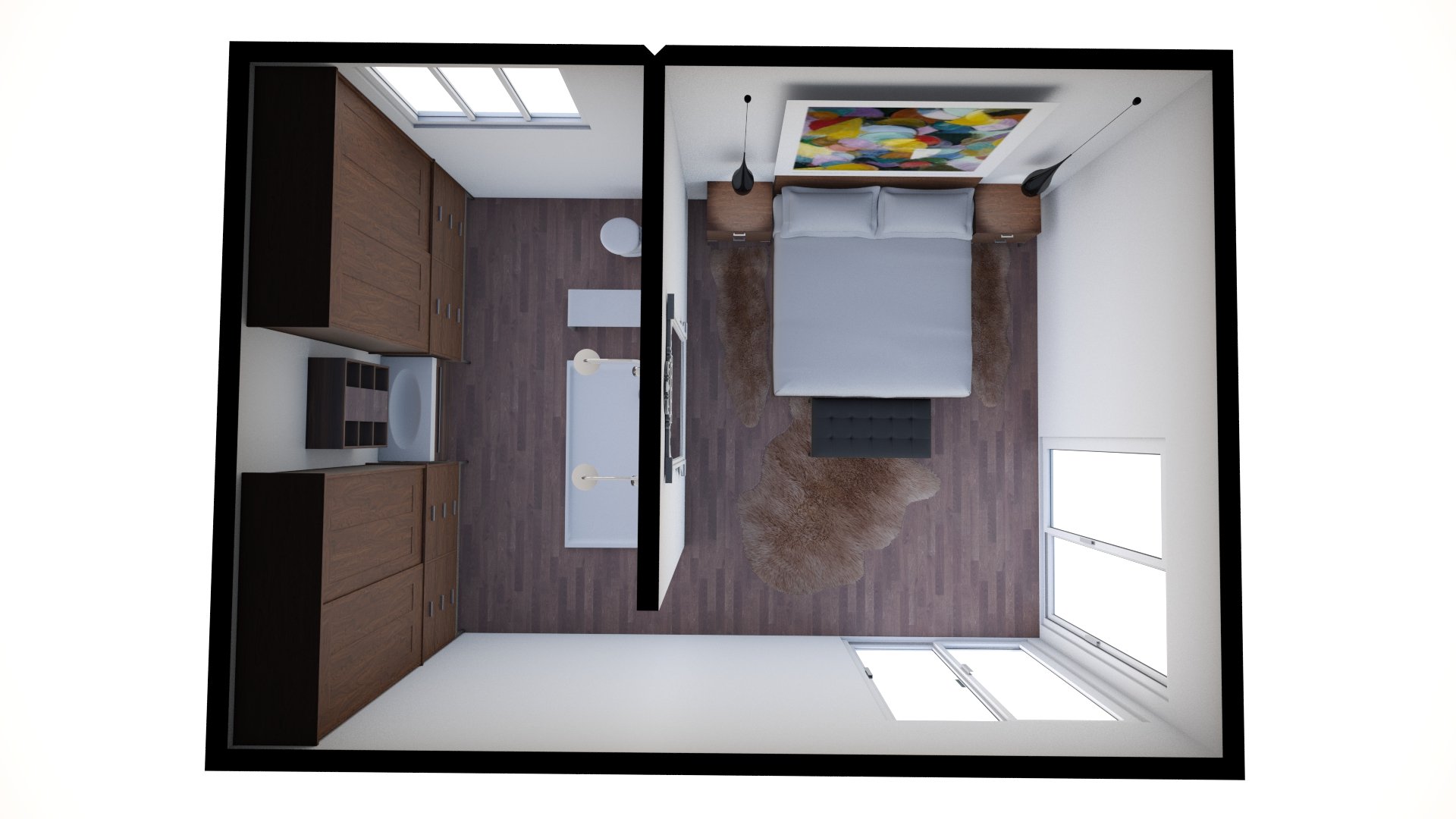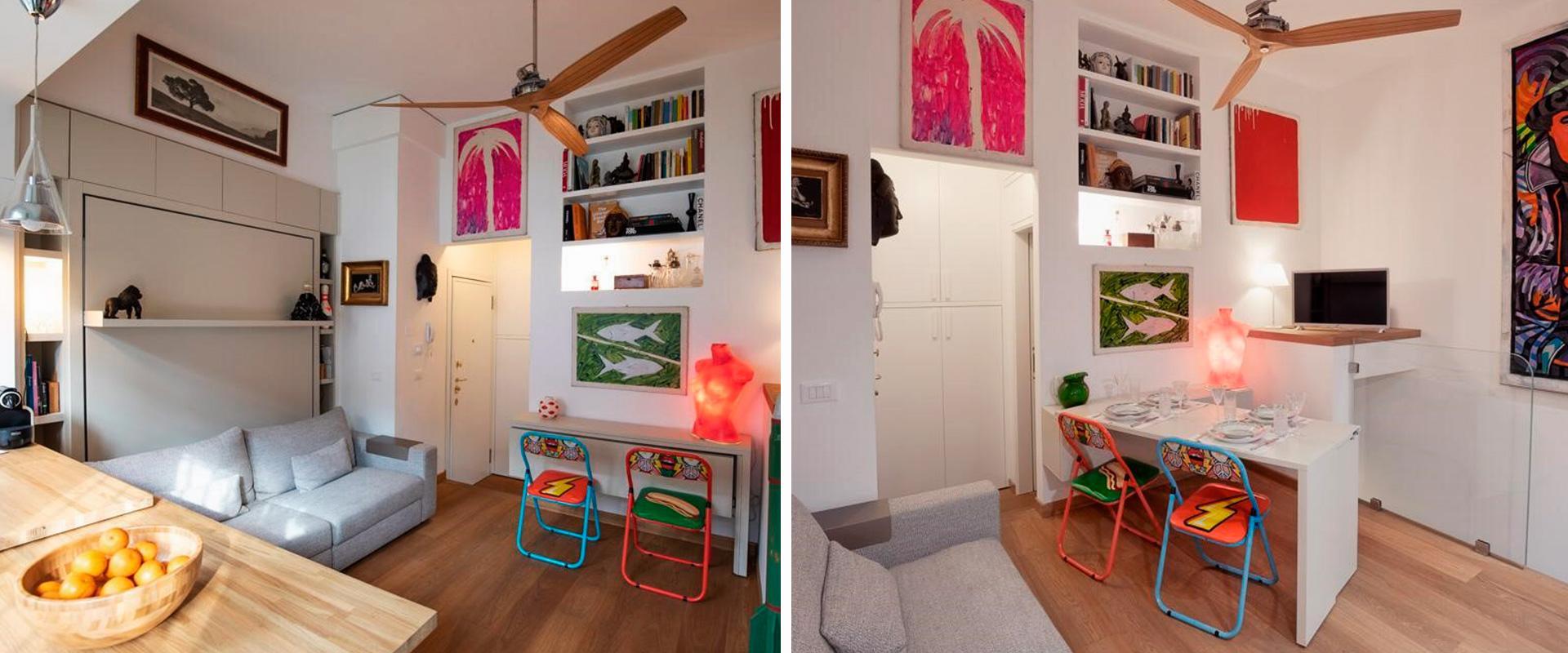Space Maximization Techniques

Transforming a one-bedroom apartment into a functional two-bedroom space requires clever utilization of every square inch. Maximizing space effectively involves a combination of vertical storage solutions, multi-functional furniture, and smart zoning techniques.
Utilizing Vertical Space Efficiently
Maximizing vertical space is a key principle in small apartment design. This approach allows you to utilize the often-neglected space above floor level, creating a sense of spaciousness while maintaining a clutter-free environment.
- Loft Beds: Loft beds are a practical solution for maximizing vertical space. They elevate the sleeping area, creating valuable floor space underneath for a desk, a seating area, or additional storage. Loft beds come in various designs, from simple metal frames to stylish wooden structures with built-in shelves or desks. For example, a loft bed with a desk underneath can create a dedicated workspace, while a loft bed with storage drawers underneath can provide ample space for clothing and personal belongings.
- Wall-Mounted Shelving: Wall-mounted shelves are an excellent way to store books, decorative items, and other essentials. They minimize floor space usage and add a touch of visual interest to the room. Floating shelves, which appear to be suspended in mid-air, are particularly popular for creating a minimalist aesthetic. Open shelving units, on the other hand, allow for easy access to items while adding a sense of openness to the room.
- Ceiling-Mounted Storage: Ceiling-mounted storage solutions are ideal for storing bulky items or seasonal belongings that are not frequently used. This could include a system of hanging baskets, storage bins, or even a small loft area accessed by a ladder. For example, a ceiling-mounted storage system can be used to store winter clothes during the summer months or to store camping gear when not in use.
Multi-Functional Furniture, How to make 1 bedroom apartment into 2
Multi-functional furniture is a crucial element in small apartment design. By incorporating furniture pieces that serve multiple purposes, you can optimize space and minimize clutter.
- Sofa Beds: Sofa beds are a classic example of multi-functional furniture. They provide a comfortable seating area during the day and transform into a bed at night, eliminating the need for a separate bed frame. Many sofa beds come with storage compartments underneath, further maximizing space efficiency.
- Murphy Beds: Murphy beds are wall-mounted beds that fold up into a compact cabinet when not in use. They are an excellent option for maximizing floor space in small apartments. Murphy beds are available in various sizes and styles to fit different needs and aesthetics.
- Storage Ottomans: Storage ottomans are a versatile piece of furniture that serves as both seating and storage. They can be used to store blankets, pillows, or other items, keeping them out of sight while adding a decorative element to the room.
Zoning Techniques
Zoning is a design technique that involves dividing a single space into distinct areas for different purposes. This can be achieved using a variety of methods, including furniture placement, lighting, and color schemes.
- Furniture Placement: Furniture placement is a key aspect of zoning. By strategically placing furniture, you can create visual boundaries between different areas of the room. For example, a large bookcase can be used to separate the living area from the sleeping area, while a sofa facing a coffee table can define a cozy conversation area.
- Lighting: Lighting can also be used to define different zones. Using different types of lighting in each area can create a distinct atmosphere and highlight the intended use of each space. For example, a bright overhead light can be used in the workspace, while soft ambient lighting can be used in the living area.
- Color Schemes: Color schemes can also be used to create distinct zones. Using different colors on the walls, furniture, or rugs can visually separate different areas of the room. For example, using a warm color scheme in the living area and a cool color scheme in the sleeping area can create a sense of separation and distinction.
Layout Design for a 1-Bedroom Apartment
The following table presents a sample layout for a 1-bedroom apartment that incorporates space maximization techniques. This is just a suggestion, and the specific layout can be adjusted to suit your individual needs and preferences.
| Area | Description | Furniture | Placement |
|---|---|---|---|
| Sleeping Area | This area should be located away from the entrance for privacy. | Loft bed with storage underneath, small nightstand, reading lamp | Near the window, utilizing the corner space |
| Living Area | This area should be positioned near the entrance to create a welcoming atmosphere. | Sofa bed with storage underneath, coffee table, rug | Centered in the room, opposite the window |
| Workspace | This area can be created within the living area using a desk or a folding table. | Desk with a chair, small bookcase, desk lamp | Near the window, utilizing the remaining space |
| Kitchen | This area should be located near the entrance for easy access. | Compact kitchen counter with sink, microwave, and small refrigerator | Against the wall opposite the living area |
Creating a Separate Bedroom: How To Make 1 Bedroom Apartment Into 2

Transforming a one-bedroom apartment into a two-bedroom space requires clever design strategies to carve out a dedicated sleeping area. This can be achieved by using room dividers, curtains, or even creating a loft bed, effectively separating the sleeping area from the living space.
Using Room Dividers, Curtains, or Bookshelves
Room dividers, curtains, and bookshelves are practical solutions to physically separate the sleeping area from the living area in a one-bedroom apartment. They offer varying degrees of privacy and visual separation, allowing you to customize the level of separation based on your preferences.
- Room dividers are freestanding screens that come in various materials, designs, and sizes. They offer a degree of privacy and visual separation while maintaining an open feel. They are easy to move and rearrange, making them ideal for flexible spaces.
- Curtains can be hung from the ceiling or a track system, providing a more fluid and adaptable barrier. They offer varying degrees of light control and privacy, depending on the fabric chosen. They are also relatively inexpensive and easy to install.
- Bookshelves can serve a dual purpose by storing books and creating a visual barrier between the sleeping area and the living area. They can be arranged in various configurations, allowing you to customize the level of separation and create a unique aesthetic.
Advantages and Disadvantages of Using a Folding Screen
Folding screens are a popular choice for temporary partitions, offering a balance of practicality and aesthetics.
- Advantages: Folding screens are lightweight, portable, and relatively inexpensive. They are easy to assemble and disassemble, making them ideal for temporary or flexible living arrangements. They come in various designs and materials, allowing you to choose a style that complements your décor.
- Disadvantages: Folding screens offer limited privacy and sound insulation. They can be unstable if not properly secured, and they may not be suitable for long-term use. They can also obstruct natural light and create a sense of claustrophobia if not positioned correctly.
Creating a Loft Bed
Creating a loft bed is a more permanent solution for separating the sleeping area from the living area. This involves building a raised platform that accommodates the bed, freeing up space underneath for a living area.
- Structural Considerations: The loft bed needs to be structurally sound and safe, ensuring that it can support the weight of the bed and its occupants. This requires careful planning and construction, including the use of sturdy materials and proper anchoring.
- Safety Precautions: It’s essential to consider safety precautions, especially if children will be using the loft bed. This includes installing a secure railing to prevent falls, using a sturdy ladder with secure handrails, and ensuring adequate headroom and ventilation. It’s also important to ensure that the platform is properly anchored to the ceiling or walls.
Visual Representation of a Bedroom in a 1-Bedroom Apartment
The following table illustrates a potential layout for a bedroom created within a one-bedroom apartment:
| Area | Description | Dimensions (Approximate) | Notes |
|---|---|---|---|
| Sleeping Area | Loft bed with storage underneath | 10 ft x 10 ft | The loft bed provides a separate sleeping area while maximizing floor space. |
| Living Area | Sofa, coffee table, and entertainment unit | 10 ft x 10 ft | The living area is located underneath the loft bed, creating a functional and comfortable space. |
| Kitchen | Countertops, sink, and appliances | 8 ft x 8 ft | The kitchen is located adjacent to the living area, offering a convenient and compact space. |
| Bathroom | Toilet, sink, and shower | 5 ft x 5 ft | The bathroom is located separately from the living and sleeping areas, providing privacy and functionality. |
Design and Decor

Creating a functional and stylish two-bedroom apartment from a one-bedroom space requires careful planning and thoughtful design choices. The goal is to maximize space while maintaining a comfortable and inviting atmosphere. Here are some tips on using color, light, mirrors, and minimalist decor to achieve a spacious and aesthetically pleasing outcome.
Using Color and Light to Create a Sense of Spaciousness
Color plays a crucial role in shaping the perception of space. Lighter colors, such as whites, creams, and pastels, reflect light and create a sense of openness and airiness. Darker colors, on the other hand, can make a room feel smaller and more enclosed.
Using a light color palette on walls and ceilings can make a small apartment feel larger. A light color scheme also allows for more flexibility when choosing furniture and accessories.
Natural light is essential for creating a spacious and inviting atmosphere. Maximizing natural light by keeping windows uncluttered and using sheer curtains allows for more light to enter the apartment.
Artificial lighting can also be used to enhance the illusion of space. Using multiple light sources, such as lamps and overhead fixtures, can create a more balanced and welcoming environment.
Using Mirrors and Reflective Surfaces to Enhance the Illusion of Space
Mirrors are a classic design trick for creating the illusion of more space. Strategic placement of mirrors can reflect light and create a sense of depth, making a room appear larger than it actually is.
Mirrors can be incorporated into various design elements, such as wall decor, furniture, or even as standalone pieces. For example, a large mirror placed opposite a window can reflect natural light and create a more expansive feeling.
Reflective surfaces, such as metallic accents and glossy finishes, can also enhance the illusion of space. These surfaces reflect light, creating a sense of brightness and openness.
Benefits of Using Minimalist Decor and Decluttering
Minimalist decor focuses on simplicity and functionality. This approach emphasizes clean lines, neutral colors, and a limited number of furniture pieces and accessories. Minimalist decor creates a sense of order and calm, which can be especially beneficial in a smaller space.
Decluttering is essential for creating a spacious and airy atmosphere. Removing unnecessary items and organizing belongings helps to create a more open and welcoming environment.
Decluttering can also make a room feel more spacious by eliminating visual clutter and creating a sense of order. It’s important to be selective about what items are kept and to find practical storage solutions for items that are not used regularly.
